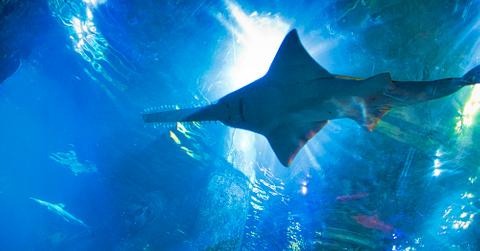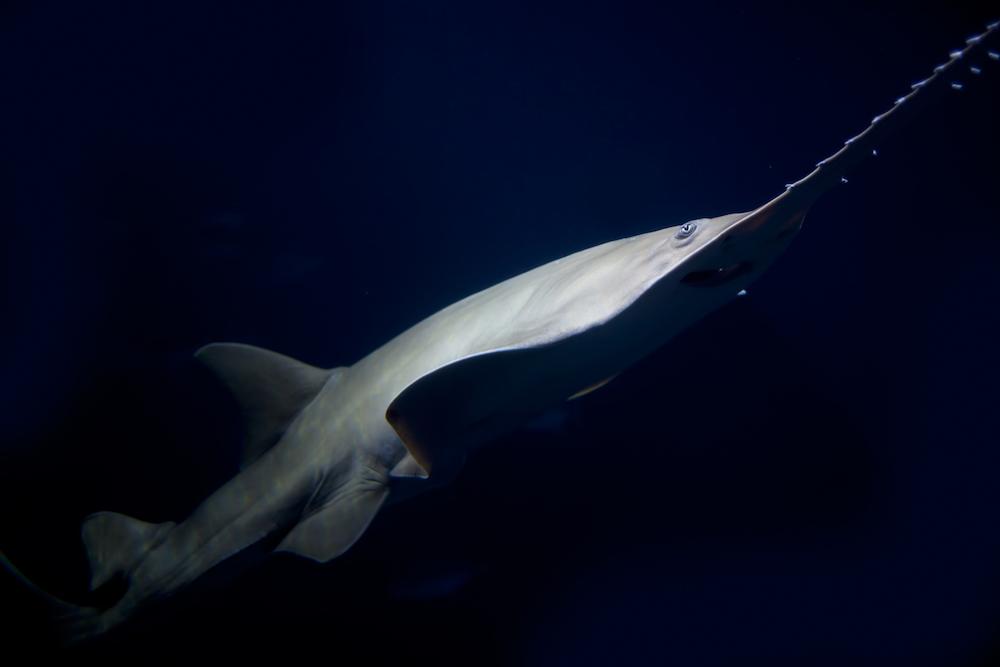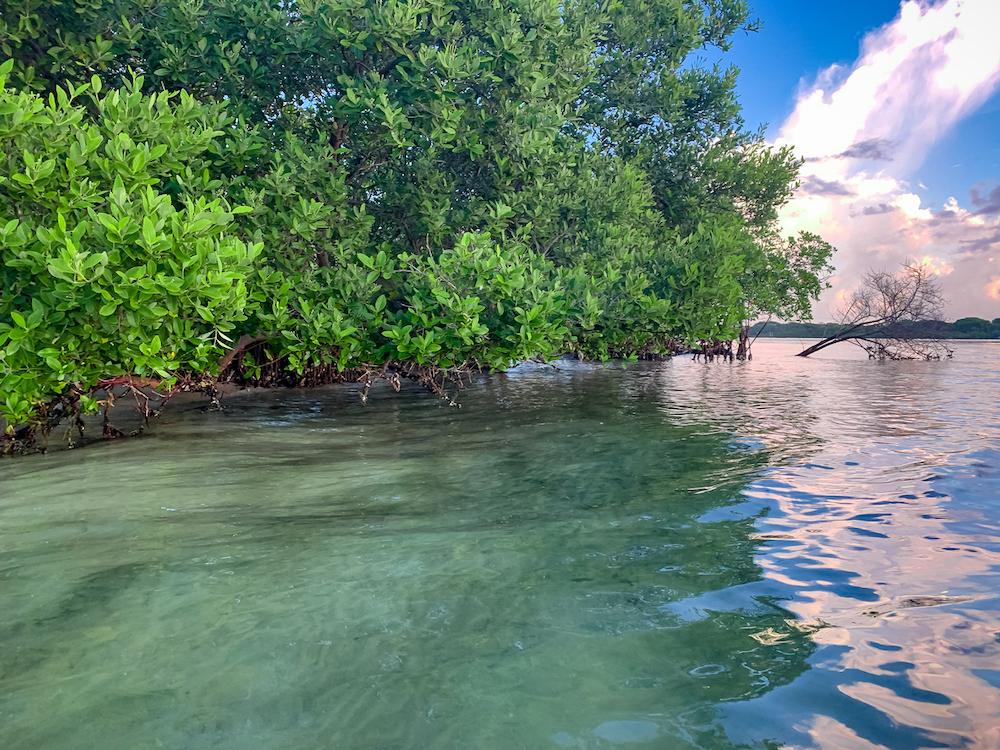Scientists Continue to Research Why Sawfish Are "Spinning" Themselves to Death
In a race against the clock, scientists have narrowed down a list of reasons why sawfish are "spinning" themselves to death.
Updated May 13 2024, 11:07 a.m. ET

Throughout the last hundred years or so, the population of an unusual-looking marine creature, the sawfish, has dramatically declined due in large part to climate change, and is now on the endangered species list.
In early 2024, reports of distressed sawfish along the shores of the Florida Keys flooded in, sparking alarm among conservation groups and residents alike. Something was killing the already endangered sawfish — and in record numbers.
Sawfish, along with numerous other fish in the Florida Keys, were spinning in circles and dying. As researchers tried to solve the mystery of what was causing the fish deaths, unprecedented rehabilitation efforts to save the critically endangered smalltooth sawfish were planned. But why are sawfish endangered to begin with, and how much of the sawfish population remains?

What is a sawfish?
Sawfish have a unique appearance with a distinct long, flat, rostrum with rostral teeth that resembles that of a saw. Although their bodies look similar to a shark (earning them the nickname "carpenter sharks"), sawfish are technically rays and are generally considered harmless if undisturbed. According to the National Wildlife Federation, the sawfish's main habitats are shallow, coastal waters and estuaries, along with mangrove forests and nurseries.
Sawfish range in size from around 10 feet to 25 feet long, depending on the species. There are five species of sawfish:
- Narrow sawfish
- Dwarf sawfish
- Largetooth sawfish
- Green sawfish
- Smalltooth sawfish.
Why are sawfish endangered?
According to the National Oceanic and Atmospheric Administration (NOAA), the population of smalltooth sawfish dropped like a stone in the late 1900s, because of habitat loss caused largely by coastal development and bycatch, as their toothed rostrums can easily get snagged in fishing nets. In 2003, the smalltooth sawfish became the first marine fish to receive federal protection under the Endangered Species Act.
There are now guidelines in place for fishermen who accidentally hook a sawfish, and NOAA has created nearly 3,000 square kilometers in southwest Florida of critical habitat —not to be confused with a refugee or protected marine area. Instead, a critical habitat makes it so federal agencies have to run any planned actions by NOAA to ensure those actions don’t make things worse for the sawfish.
Per NOAA, climate change poses a massive threat to sawfish because events like rising sea levels, heating oceans, severe and shifting weather, and flooding all contribute to habitat loss for the sawfish. Smalltooth sawfish require specific salinities, and inputs of freshwater into coastal estuaries — where sawfish thrive — can alter these salinity levels.

How many sawfish are left in the world?
Unfortunately, all five species of sawfish are critically endangered. According to National Geographic, sawfish have been declared "locally extinct" in more than 20 different countries, and although there are still occasional sawfish sightings in offshore waters worldwide, there are now just two remaining sawfish hotspots: Florida and northern Australia.
Smalltooth sawfish, who once thrived in the coastal waters from North Carolina to Texas, can now be found almost exclusively in Florida, with as somewhere between 200 and 5,000 remaining, per the National Resource Defense Council.
What happened to the sawfish in the Florida Keys?
In November of 2023, local Florida Keys residents began reporting unusual behavior in fish populations. Videos surfaced of sawfish, pinfish, angelfish, amber jacks, mangrove snappers, boxfish, and many other species spinning and flailing in circles. The fish were spinning themselves to death. Concerned citizens formed online “spinning fish” social media groups to discuss the problem, share videos, and report findings to the Florida Fish and Wildlife (FWC), which keeps records of fish kills.
Some residents were quick to point to the water releases from Lake Okeechobee, which is notoriously prone to algal blooms, as a possible cause. According to the Army Corp of Engineers, water releases were increased in February 2024 due to above average-rainfall from El Niño.
From January to March 30, 2024, the FWC reported 28 sawfish mortalities, but found no signs of toxins associated with red tide (Karenia brevis), nor did the agency find bacterial infections or signs of communicable pathogens. Per National Geographic, testing is also being done surrounding heightened levels of Gambierdiscus, a seafloor algae. Because sawfish are negatively buoyant, they’re unlikely to float after death, so researchers fear that the number of sawfish impacted is much higher than reports show.
In May 2024, scientists told NBC News that researchers' tests on the sawfish revealed a "cocktail of natural toxins" in both the seawater and the fish themselves.
Alison Robertson, a senior marine scientist at the Dauphin Island Sea Lab, told the outlet, "The hypothesis I’m working on at the moment is really that the combination of these various benthic algal toxins are coming together to create the phenomenon we’re seeing."
Tragically, while the algae appears to be a good lead, Robertson said there is still "no obvious smoking gun" and that the algae toxins could be in combination with other environmental toxins too.
As of writing, at least 40 sawfish are dead, with over 100 sawfish witnessed "spinning," per Local News 10.
What's being done about the endangered sawfish in the Florida Keys?
As investigations continue regarding the cause of the “spinning fish,” the spike in endangered sawfish deaths prompted NOAA to launch an unprecedented emergency response to rescue and rehabilitate smalltooth sawfish. The initiative was announced March 24, 2024, as a joint effort across multiple agencies, including Ripley Aquariums, Mote Marine Laboratory, and Dynasty Marine Associates, Inc., which will be housing the fish so veterinarians and scientists can attempt rehabilitation.
How to help sawfish recovery efforts:
If you’d like to help save the sawfish, Mote Marine Laboratory is accepting financial donations for the cause. Donations can also be made to the Havenworth Coastal Conservation, which is a partner in the NOAA-led emergency response. Additionally, any Florida sawfish sighting should be immediately reported to the FWC.
This article, originally published on April 1, 2024, has been updated.